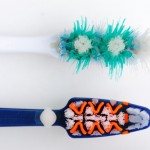
In Europe the first mass produced bristle toothbrushes came into use in the 18th Century. Although hog bristle brushes were reported in China during the Tang Dynasty (619-907). Today nylon toothbrushes are in widespread use and manual brushes come in a wide range of brush head sizes with multiple tufts often angled in different directions. The aim of this review was to look at the efficacy of manual toothbrushing with respect to toothbrush design and brushing duration.
What did they do
The Medline and Cochrane Central Register of Controlled Trials (CENTRAL) databases were searched for randomised (RCTs ) or controlled clinical trials (CCTs) that evaluated the effect on dental plaque in a brushing exercise in healthy adults. In addition, reference lists of selected papers were searched. Only studies involving use of single headed brushes in adults( ≥18 yrs age) with no orthodontic appliances or removable dentures were included. Papers were screened independently, quality assessed and data abstracted by two reviewers independently. A random effects meta-analysis was performed.
What did they find.
59 papers (52 RCTs, 7CCTs) with 212 brushing exercises as separate legs of the experiments were included. Forty-two of the RCTs and two CCTs had a crossover design, six RCTs and two CCTs were not well described, the remainder used parallel design.
- Overall, brushing resulted in a 50% weighted mean plaque score reduction (95% CI: 46.54; 55.40).
- In studies using the Quigley and Hein plaque index, the weighted mean reduction was 30%(95% CI: 26.79; 33.21).
- In studies using the Navy plaque index. the weighted mean reduction was 53% (95% CI: 49.51; 56.49)
- Subanalysis between the different bristle tuft configurations illustrated variation in plaque removal ability (24–61%).
- The angled bristle design numerically showed the highest mean plaque reduction with either index.
In 150 experiments the brushing time was 1 min. Brushing time in other experiments varied between 15 s and 5 min. In five experiments, there was no time limit, but the brushing duration was based on individual habits. A subanalysis of brushing duration revealed after 1 min, a mean reduction of 27% and after 2 min,41%.
The authors concluded
The efficacy in plaque removal following a brushing exercise is a reduction from baseline plaque scores of 50% on average, with a variation of 30–53% dependent on the plaque index used. The available evidence indicates that bristle tuft arrangement (flat trim, multilevel, angled) and brushing duration are factors that contribute to the variation in observed efficacy.
Comment
The authors themselves highlighted a number of limitations to the review, restriction to English language studies and the significant degree of heterogeneity in the included studies are potential issues. The impact of patients participating in the study also neeeds to be taken into consideration. Apart from the duration of brushing there is also no indication given as to whether the studies are one off interventions or whether they were of a longer duration.
A Cochrane review comparing manual versus powered toothbrushes found that
Brushes with a rotation oscillation action removed plaque and reduced gingivitis more effectively than manual brushes in the short term and reduced gingivitis scores in studies over 3 months.
The Cochrane review found for plaque there was an 11% difference on the Quigley Hine index at 3 months.
Links
Slot D, Wiggelinkhuizen L, Rosema N, Van der Weijden G. The efficacy of manual toothbrushes following a brushing exercise: a systematic review. Int J Dent Hyg. 2012 Jun 6. doi: 10.1111/j.1601-5037.2012.00557.x. [Epub ahead of print] PubMed PMID: 22672101.
Robinson P, Deacon SA, Deery C, Heanue M, Walmsley AD, Worthington HV, Glenny AM, Shaw BC. Manual versus powered toothbrushing for oral health. Cochrane Database of Systematic Reviews 2005, Issue 2. Art. No.: CD002281. DOI: 10.1002/14651858.CD002281.pub2.
Deacon SA, Glenny AM, Deery C, Robinson PG, Heanue M, Walmsley AD, Shaw WC. Different powered toothbrushes for plaque control and gingival health. Cochrane Database of Systematic Reviews 2010, Issue 12. Art. No.: CD004971. DOI: 10.1002/14651858.CD004971.pub2.

[…] The Dental Elf. Leer más de Noticias cepillado, […]